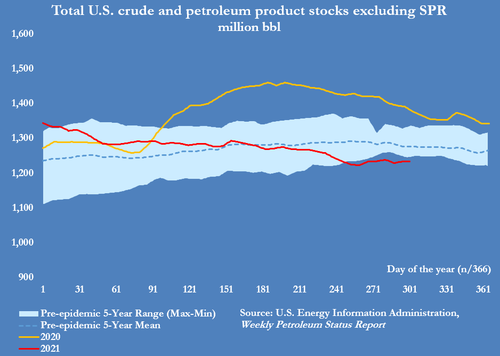Depleted US Oil Inventories Leave Market Vulnerable To Shocks
By John Kemp, Reuters energy analyst and columnist
U.S. petroleum consumption has returned to pre-pandemic levels as businesses have reopened and internal road and air travel has resumed, but production and refining are lagging behind, which has depleted stocks.
Last week, the total volume of petroleum products supplied to the domestic market averaged 20 million barrels per day, essentially the same as the pre-pandemic five-year seasonal average for 2015-2019.
Of the major fuels, volumes of gasoline and distillate supplied are running at or marginally above pre-pandemic rates, while jet fuel is still somewhat below, reflecting continued problems in the aviation industry. But the volume of crude processed by refineries has been running roughly 5% below pre-pandemic rates, putting downward pressure on inventories of refined fuels.
By the end of last week, gasoline stocks were 5 million barrels below their pre-pandemic seasonal average while distillate stocks were 6 million barrels below (“Weekly petroleum status report”, EIA, Nov. 3).
Domestic crude production also remains well below pre-pandemic levels, which has resulted in an even stronger drawdown in crude inventories.
Commercial crude inventories ended last week 18 million barrels (4%) below the pre-pandemic average with the most severe shortage concentrated at Cushing, where stocks were down 25 million barrels (48%).
The acute shortage at Cushing, which is the delivery point for the NYMEX crude futures contract, helped push nearby futures prices into their second-steepest backwardation in the last decade.
More broadly, total stocks of crude and products outside the strategic petroleum reserve had fallen to their lowest level since 2014 (https://tmsnrt.rs/3whzjLX).
But there are some tentative signs the supply situation is stabilizing: deficits in both crude and products inventories to the pre-pandemic five-year average have narrowed slightly since late September.
Likely in response, WTI futures prices for deliveries in December 2021 have been trending gently downwards since Oct. 26 and the six-month calendar spread has been softening since Oct. 29, though it is too early to determine whether this marks a turning point or simply a temporary pullback.
The overall supply situation remains tight. Depleted inventories mean there are few shock absorbers to cope with any unexpected interruption in output or stronger than anticipated growth in consumption.
At this point, supply problems or unexpected strength in demand could result in sharp price increases because there is no slack left to absorb them in the short term, unless OPEC+ can be persuaded to increase its output faster.
Tyler Durden
Thu, 11/04/2021 – 19:25![]()
Zero Hedge’s mission is to widen the scope of financial, economic and political information available to the professional investing public, to skeptically examine and, where necessary, attack the flaccid institution that financial journalism has become, to liberate oppressed knowledge, to provide analysis uninhibited by political constraint and to facilitate information’s unending quest for freedom. Visit https://www.zerohedge.com







